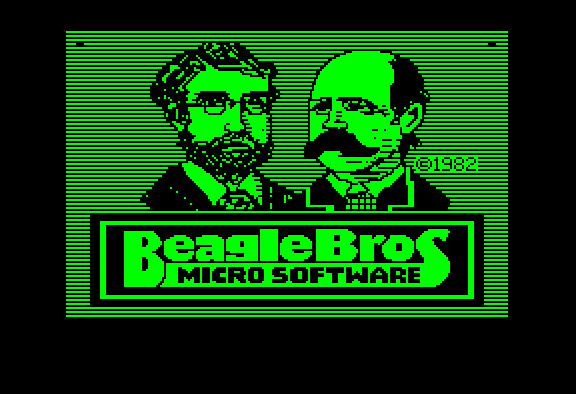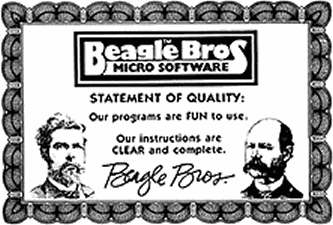Using our programs is fun
- Transfer
These two fictional guys influenced me a lot in terms of programming:
Instead of providing guarantees for compatibility or error-free operation, the software from the Beagle Brothers promised something else: fun.
Games with strange Beagle Brothers floppy disks on an Apple II computer in high school, and the buffet of all the programs that were written for them, became a rite of passage for me.
Many crazy people, including myself, wrote horrible programs on AppleSoft BASIC, and they did it for money. And at the same time they enjoyed it. It turns out that the best way to create programs that delight users is to take pleasure in creating them .



Moreover, they taught me how much fun it is to learn by playing with an interactive dynamic program, instead of just reading books. That is why I have always resisted the desire to add “introductory videos”, external documentation, walkthrough instructions, and so on. One of the programs on these diskettes from the Beagle Brothers (I don’t remember which, and for what reason), displayed the following:

And I thought - wow. That's what these floppy disks are trying to do — interactive animated tutorials that teach programming and working with Apple II. Amazing
This idea has stuck in my head for 20 years. Imagine a world in which textbooks do not consist only of a solid text, but involve the student in the process, play with him and encourage experimentation, right on their pages.
And now that JavaScript and HTML 5 have reached such heights, you can create the interactive tutorials that the Beagle Brothers dreamed of in 1985, which would only be available with a browser and the Internet.
Here are some great examples I typed.
Visualizing Algorithms - visualization of various interesting and popular algorithms
Parable of the Polygons- a game with social implications
Sight and Light - an interactive explanation of the calculation of visibility in 2D
Rolling Shutters - an animated explanation of the glitches of digital cameras associated with
Sorting.at photosensors - visualization of common sorting algorithms
The future of games history is workplace theft - an illustration of the history of the development of programs where Wolfenstein 3D is built right into the page.
In the old evil times, we studied book programming. Instead of reading dry text :

you can learn this interactively . They read, tried, looked at the result:

Try, write something, and see what happens.
I would like my three children to learn from their teachers and other children, as has always been the case. But I also want them to have access to a better type of book than mine. To books, which are essentially programs. Interactive, animated books that let you play, experiment, and create, not just passively read them.
I want them to learn, like me, that using our programs is fun.



Moreover, they taught me how much fun it is to learn by playing with an interactive dynamic program, instead of just reading books. That is why I have always resisted the desire to add “introductory videos”, external documentation, walkthrough instructions, and so on. One of the programs on these diskettes from the Beagle Brothers (I don’t remember which, and for what reason), displayed the following:

Someday all books will be interactive and animated.
And I thought - wow. That's what these floppy disks are trying to do — interactive animated tutorials that teach programming and working with Apple II. Amazing
This idea has stuck in my head for 20 years. Imagine a world in which textbooks do not consist only of a solid text, but involve the student in the process, play with him and encourage experimentation, right on their pages.
And now that JavaScript and HTML 5 have reached such heights, you can create the interactive tutorials that the Beagle Brothers dreamed of in 1985, which would only be available with a browser and the Internet.
Here are some great examples I typed.
Visualizing Algorithms - visualization of various interesting and popular algorithms
Parable of the Polygons- a game with social implications
Sight and Light - an interactive explanation of the calculation of visibility in 2D
Rolling Shutters - an animated explanation of the glitches of digital cameras associated with
Sorting.at photosensors - visualization of common sorting algorithms
The future of games history is workplace theft - an illustration of the history of the development of programs where Wolfenstein 3D is built right into the page.
In the old evil times, we studied book programming. Instead of reading dry text :

you can learn this interactively . They read, tried, looked at the result:

Try, write something, and see what happens.
I would like my three children to learn from their teachers and other children, as has always been the case. But I also want them to have access to a better type of book than mine. To books, which are essentially programs. Interactive, animated books that let you play, experiment, and create, not just passively read them.
I want them to learn, like me, that using our programs is fun.
